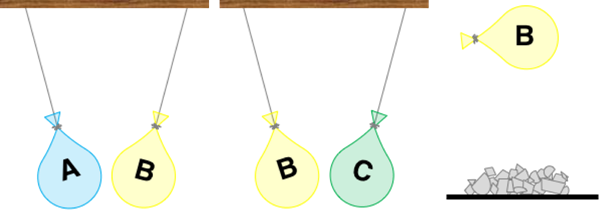It's All About Reasoning
Like a lot of our Concept Builders (but maybe more so with this one), you have some thinking and logical reasoning to do. The physics rules are straight-forward:
- opposites attract,
- likes repel, and
- charged and neutral attract.
But the application of these simple rules can get complicated. Get yourself organized and prepare to reason.
The Game Plan
This question is about Balloon C. The charge of Balloon A is stated. But Balloon C does not interact with Balloon A; it only interacts with Balloon B. So you must first figure out what charge Balloon B has from its interaction with Balloon A and with the neutral paper bits. It would be best to look at the Paper Bits interaction first. That is discussed in the next section - What's With the Paper Bits? Then do some reasoning regarding what information you learn about Balloon B to reason towards the possibilities for Balloon C. You got this!
What's With the Paper Bits?
Note that Balloon B and neutral paper bits do not interact. This lack of interaction provides evidence that Balloon B is neutral. If Balloon B were charged, then it would attract the paper bits and lift them off the table. But a neutral balloon and neutral paper bits would not interact at all. By itself, this observation provides rather conclusive evidence regarding Balloon B's charge state. And because of this you won't need to pay attention to its interaction with Balloon A. You already know that Balloon B is neutral.
Careful about Attraction
Observe that Balloons B and C attract. There are two reasons for why two balloons attract. They could be oppositely charged or one could be charged and the other is neutral. Because we have already learned from the paper bits observation that Balloon B is neutral, we can conclude that Balloon C must be the charged object in this interaction.
But what is equally important to know about a charged balloon attracting a neutral balloon is that the actual type of charge cannot be determined from this observation alone. This is because both a positive and a negative balloon would attract a neutral balloon in the same manner.
